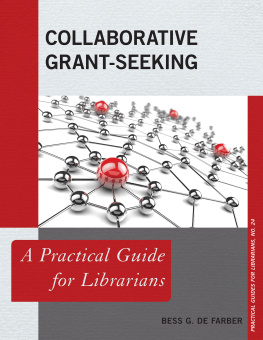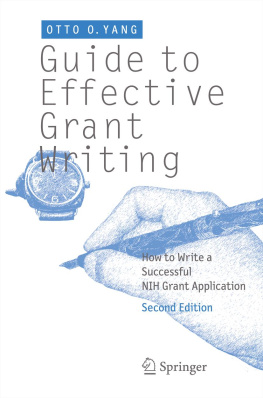 ALA Editions purchases fund advocacy, awareness, and accreditation programs for library professionals worldwide.
ALA Editions purchases fund advocacy, awareness, and accreditation programs for library professionals worldwide.  Throughout her thirty-year library career, Nancy Kalikow Maxwell has participated in successful grant projects totaling more than ten million dollars, with more than one million of those dollars flowing directly to the library. She is the author of Grant Money through Collaborative Partnerships (ALA, 2012) and wrote the chapter Grant Writing in Retirement that appears in the book Writing After Retirement: Tips by Successful Writers (forthcoming, Scarecrow Press). Formerly library director at Miami Dade College (Miami, Fla.) and Barry University (Miami Shores, Fla.), Maxwell currently owns and operates Kaliwell, Inc. (. 2014 by the American Library Association Extensive effort has gone into ensuring the reliability of the information in this book; however, the publisher makes no warranty, express or implied, with respect to the material contained herein.
Throughout her thirty-year library career, Nancy Kalikow Maxwell has participated in successful grant projects totaling more than ten million dollars, with more than one million of those dollars flowing directly to the library. She is the author of Grant Money through Collaborative Partnerships (ALA, 2012) and wrote the chapter Grant Writing in Retirement that appears in the book Writing After Retirement: Tips by Successful Writers (forthcoming, Scarecrow Press). Formerly library director at Miami Dade College (Miami, Fla.) and Barry University (Miami Shores, Fla.), Maxwell currently owns and operates Kaliwell, Inc. (. 2014 by the American Library Association Extensive effort has gone into ensuring the reliability of the information in this book; however, the publisher makes no warranty, express or implied, with respect to the material contained herein.
ISBNs: 978-0-8389-1211-9 (paper); 978-0-8389-9679-9 (PDF); 978-0-8389-9680-5 (ePub); 978-0-8389-9681-2 (Kindle). For more information on digital formats, visit the ALA Store at alastore.ala.org and select eEditions. Cover design by Kim Thornton. Cover image Stokkete/Shutterstock, Inc. Contents Indexes C ongratulations. By finding this book and flipping to the introduction, you have advanced one step further than most people.
Just about everyone who works in a library wants grant money, but few ever do anything to get some. When librarians learn that I am a grant writer, they invariably respond with, Boy, does my library need a grant. We desperately need a new boiler, an updated circulation system, e-book readers, a new childrens room, and so on. Or the honest ones (who hold a special place in my heart) will ignore their professional responsibilities and instead say, I need a trip to Tahiti. Are there any grants for that? But no matter what they dream of, most never get past the I want stage. Those who do are frequently prompted by others.
Someone (usually the boss) shoots them an e-mail with the subject Grant Opportunity. Something for us to think about, reads the message accompanying the announcement of new grant funding. But what most people think about is how much work a grant involves. They click delete and hope the boss forgets about it. There is no denying that pursuing a grant is, indeed, additional work. A former supervisor of mine would not even entertain the notion of grant funding.
No grants, no grants, she would repeat like a mantra whenever I broached the subject. We did that years ago. Way too much work. Another colleague told me that she would rather kill herself than write a grant. One library director considered turning down a job offer because it included administering a major federal grant. She did take the position, but vowed to never pursue another grant.
Her resolve lasted only six months, when she received one of those previously mentioned grant announcement e-mails. Since it came not from her boss, but from the college president, she had no choice but to pursue another one. Whether it is your idea (hopefully) or that of your boss (or the president), by obtaining and reading this book, you are at least investigating grant funding sources for your library. Once again, congratulations for getting this far. You go, girl (or boy). But before you flip to your states listings and begin scanning listings for that perfect funding source, you may want to read the rest of this introduction.
You, like many potential grant developers, may not be what is known in the field as grant ready. Grant Readiness Grant experts differ in the advice they provide grant seekers, but one recommendation they would all agree upon is that grant seekers must come to the grant development process prepared. Several steps should be taken beforehand. Readers of a certain age may remember those Leave It To Beaver shows, when the father would come home from work, take off his coat and pull up to the dinner table, ready to enjoy a delicious dinner. The meal magically appeared before him, with none of the wifes pervious toil or preparation in evidence. And so it can be for grant development.
To the uninitiated it appears that a successful grant proposal blossoms effortlessly without any previous preparation. But this is deceiving. An incredible amount of work isor shouldbe done before beginning any grant search. The following are the most common components to assemble before launching a grant project. Components to Becoming Grant-Ready STRATEGIC PLAN As the old adage has it, if you dont know where you are going, any road will get you there. Or, as they say in the US Army, You cant hit a target you cant see.
In order to hit the target of grant funding, a grant seeker must make sure the goals of the requesting institution fit those of the granting agency. An organizations aims must be clearly stated in order for the funder to recognize if it matches their own. Fortunately, most libraries already have a strategic plan and mission statement in place. For some, the parent organizations overarching goals serve as the librarys goals. For instance, if a colleges mission is to prepare graduates for a successful culinary arts career then the librarys mission may simply be to provide support to prepare successful culinary art students. Other libraries may similarly mirror the parent organization, but include specifics about how the parent will be served.
For instance, the library mission may be to provide the library services, collections, and instructional and technical support needed for the organization to accomplish its mission, which is... (with the institutions mission repeated). No matter what the strategic plan includes, the funder must be convinced that the librarys stated goals and that of the funding agency are symbiotic. If the library does not have an updated strategic plan it will be difficult to demonstrate that the library is the appropriate organization to meet the funders goals. On the other hand, when a librarys clearly stated goals overlap with those of the funding agency, the chances of a proposals success are enhanced immeasurably. Especially powerful are instances when the same words in a librarys strategic plan appear in the stated goals of the funding source.
For instance, if one of the goals of the library is to improve the effectiveness of nonprofit organizations in Polk County, and a funder issues a grant to provide computer training to make Polk County nonprofit employees more effective, the chances of crafting a successful proposal are excellent. However, if a librarys goals are to serve the schools student population, a funding opportunity for staff development would be harder to demonstrate. A case can be made that student performance will be improved through teacher training, but it would be easier to justify if staff and faculty development appeared somewhere in the organizations official plan. Before you search for any grant funding, it will behoove you to pull out your organizations strategic plan. Review the wording and keep the key phrases in mind as you review grant opportunities. If your organization does not have such a plan, you may want to postpone any grant searching until one is produced.
NEEDS ASSESSMENT Unlike the strategic plan, which most libraries already have, few libraries approach a grant search with a thorough needs assessment in hand. Actually, the needs assessment encompasses two components: the assessment of library needs and an assessment of the users need for the service or product. Both are explained below. Library Needs Assessment The first needs assessment that should be completed before a grant search begins is the identification of the librarys top priorities for funding. Though this sounds easy, it is anything but. The answer to What does the library need? will be different depending on who is doing the answering.
Next page








 ALA Editions purchases fund advocacy, awareness, and accreditation programs for library professionals worldwide.
ALA Editions purchases fund advocacy, awareness, and accreditation programs for library professionals worldwide.  Throughout her thirty-year library career, Nancy Kalikow Maxwell has participated in successful grant projects totaling more than ten million dollars, with more than one million of those dollars flowing directly to the library. She is the author of Grant Money through Collaborative Partnerships (ALA, 2012) and wrote the chapter Grant Writing in Retirement that appears in the book Writing After Retirement: Tips by Successful Writers (forthcoming, Scarecrow Press). Formerly library director at Miami Dade College (Miami, Fla.) and Barry University (Miami Shores, Fla.), Maxwell currently owns and operates Kaliwell, Inc. (. 2014 by the American Library Association Extensive effort has gone into ensuring the reliability of the information in this book; however, the publisher makes no warranty, express or implied, with respect to the material contained herein.
Throughout her thirty-year library career, Nancy Kalikow Maxwell has participated in successful grant projects totaling more than ten million dollars, with more than one million of those dollars flowing directly to the library. She is the author of Grant Money through Collaborative Partnerships (ALA, 2012) and wrote the chapter Grant Writing in Retirement that appears in the book Writing After Retirement: Tips by Successful Writers (forthcoming, Scarecrow Press). Formerly library director at Miami Dade College (Miami, Fla.) and Barry University (Miami Shores, Fla.), Maxwell currently owns and operates Kaliwell, Inc. (. 2014 by the American Library Association Extensive effort has gone into ensuring the reliability of the information in this book; however, the publisher makes no warranty, express or implied, with respect to the material contained herein.